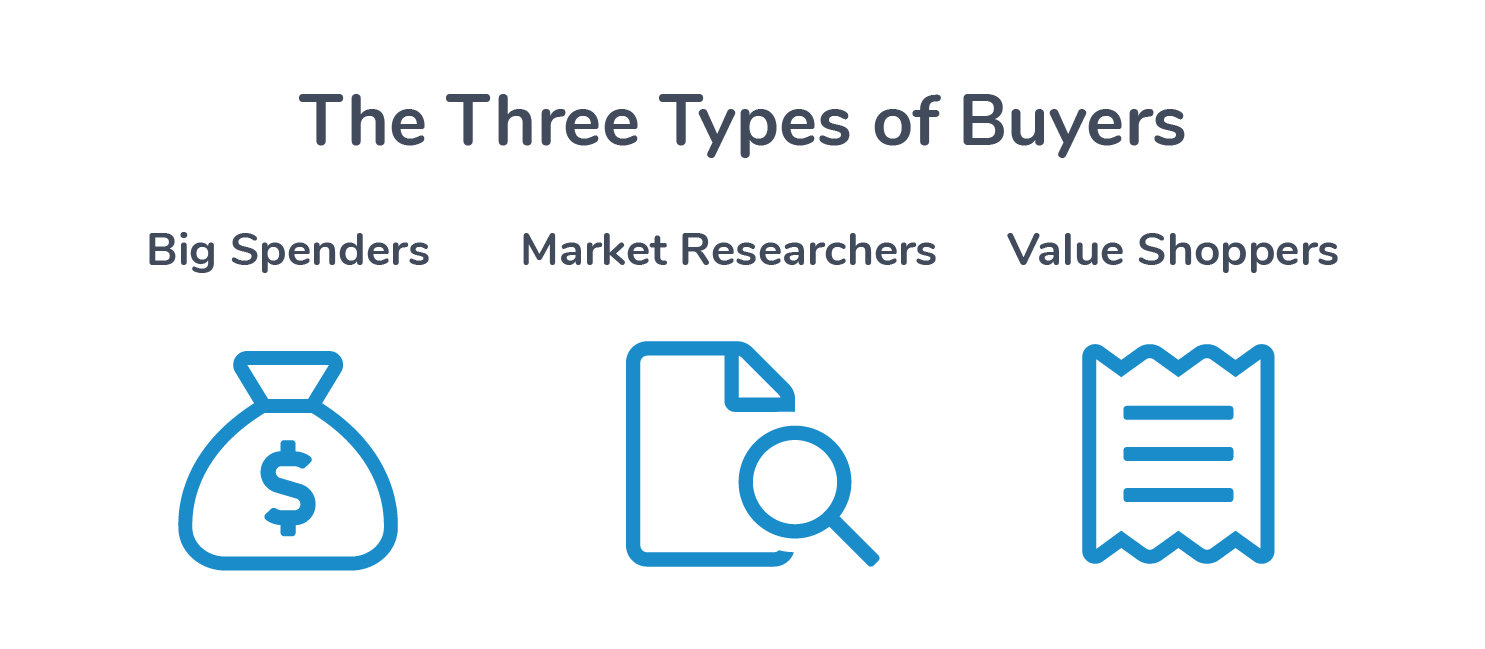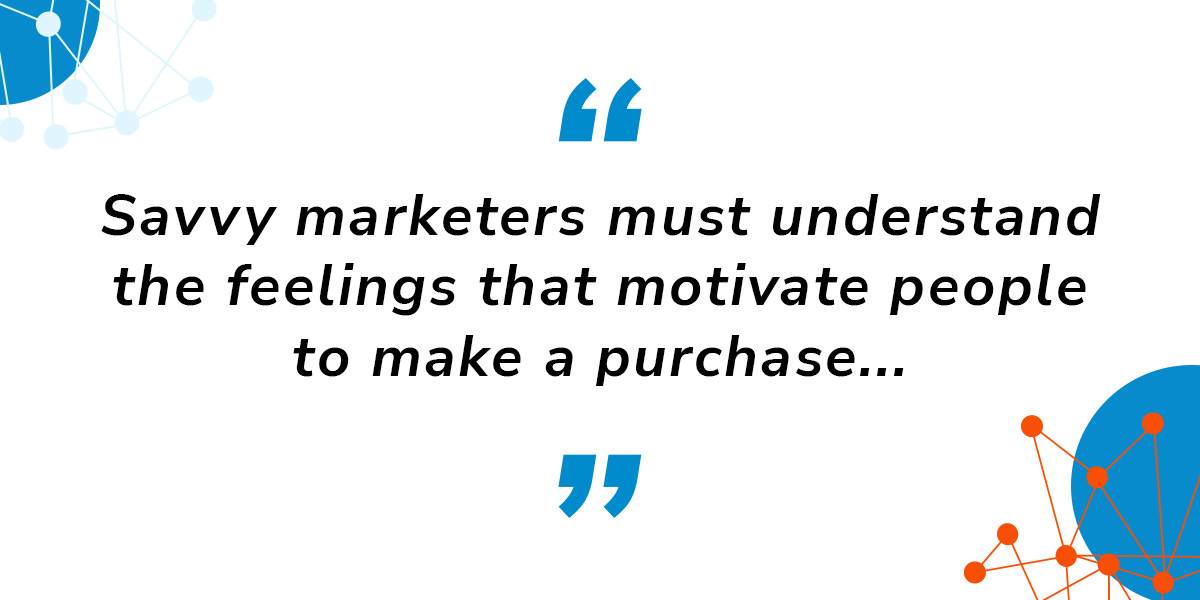What are the Different Types of Buyers?
December 8, 2020 •DJ Team

If you’re reading this article, there’s a really good chance you typed a phrase like “What are the Different Types of Buyers?” or “4 types of buyers” into a search engine. If you didn’t, for the sake of exercise, take a quick minute to enter the title of this blog into your search engine of your choice. Your mileage may vary, but when we attempt this, you’ll see a lot of numbers:
The Six Types of Buyers
What are the Four Types of Customers?
The Two Types of Buyers in Sales
Name a number, and it seems like there’s an authoritative way of collecting every customer your business will encounter into a grouping of that size. You might even find our article about Five Types of Consumers in Marketing on the first page of your results. Hmm, who wrote that one?
In that previous post, we wrote about a group of five types of customers from the perspective of their loyalty to your brand. Loyal customers require regular re-engagement for repeat business. There are also wandering customers who don’t even know what they’re looking for yet. And there are others still who will fit into different stages of the customer journey from awareness of your brand, to consideration of your offerings, to a decision to purchase from you.
With that in mind, in this blog, we’d like to look at a different kind of classification of buyers. When used in combination with the types of consumers we wrote about previously, this can give you a whole new perspective on how you balance key elements of your messaging for different types of buyers.
3 Types of Customers and How to Capture Their Attention

One helpful way to think about your customers is based not on their relationship to your brand, but on their spending habits. Some consumers are more than happy to spend on something they want. Others need to learn as much as they can before buying, and others still don’t part with their money easily at all. In each case, a unique approach to marketing messaging is necessary to resonate properly. The three types of buying are listed below.
1. The Big Spenders
Sometimes referred to as “spendthrifts” or “impulse buyers,” Big Spenders are the people whose grandmothers would chide them about money burning a hole in their pockets. These are people who act quickly to make purchases, not necessarily because they love spending or want to flaunt their money, but because they are moved to spend on a more emotional level than other types of buyers.
How do you reach them: Big Spenders react positively to marketing messages with a strong sense of emotionality. The better you can resonate with their feelings, the more likely they’ll make a quick purchase decision. Keep in mind that while it’s easy to use negative emotion in marketing—think about those cheesy as-seen-on-TV infomercials that show people losing their minds because daily tasks are so difficult—you’re much more likely to build a genuine connection with big spenders by resonating with their positive emotions. Avoid listing out the features of your product or service. Instead, speak to how your product or service will make them feel—relieved, empowered, improved—for quick wins.
2. The Market Researchers
In the middle of our spending spectrum, Market Researchers like to do their homework before making a purchase. They’re not itching to buy as soon as possible—but they’re not exactly cost-averse, either. These buyers want to review plenty of information about the products and services they need before making a decision, including case studies, product or service descriptions, reviews, and more.
How do you reach them: The key to a Market Researcher’s wallet is through good, hard data. The more content you can provide to this type of buyer, the better. While emotions will still play a role in how these consumers react to your messaging, this is an audience that does well with a “choose your own adventure” style experience with your brand’s digital presence. Make sure your website is filled to the brim with educational blog posts, reviews, case studies, and whitepapers/eBooks to give Market Researchers the information they need to pull the trigger. Use data and statistics from reputable sources and even use data from within your business to prove that you are the best option for this type of buyer to choose.
3. The Value Shoppers
Finally, if the Big Spenders are your easy sells, the Value Shoppers are anything but. These are frugal consumers who know how to budget and are serious about getting the absolute most for their dollar. Though their perspective on spending might seem miserly, it’s safe to assume that no matter the reason for a Value Shopper’s thrift, they’re driven not by gut impulse or large amounts of data, but by a strong sense of value.
How do you reach them: If emotion and information represent two sides of the rhetorical triangle, value is a great representation of the third side. In order to make a compelling argument for your product or service to Value Shoppers, you need a solid understanding of what your best customers value about your brand over the competition. Is it price? Reliability? A warranty or guarantee? Appealing to these buyers means doing plenty of research to understand your true differentiating factor in the marketplace and making that comparison clear as crystal. Presenting some case studies from your current customers will help with the persuasion as well.
Understand Buyer Personality Types with DemandJump

The key to reaching customers in each one of these classifications of buyers is to know them well. Savvy marketers must understand the feelings that motivate people to make a purchase, the relevant information that will empower them, and the values they look for in whatever it is you are offering. With the powerful Consumer Insights tools in DemandJump, you can get a direct line into your audience’s brains with a look at the top questions they ask, websites they visit, and topics they explore as they work their way to a purchase decision. This tool will also show you where both you and your competitors rank for these keywords. You can then decide which ones to use in future content to attract more customers. Sign up for a free trial to get the whole story about your customers and their path to purchase.
Featured Articles
Categories
- Attribution Tracking (13)
- Channel Optimization (11)
- Consumer Insights (68)
- Content Marketing (251)
- Data Science (8)
- Digital Marketing (6)
- Digital Transformation (26)
- Enterprise (10)
- Lead Generation (14)
- Market Intelligence (8)
- Marketing Analytics (39)
- Marketing Attribution (57)
- Marketing Management (153)
- Marketing Operations (86)
- Organic Search (222)
- Paid Search (52)
- Pillar-Based Marketing (63)
- Programmatic Advertising (9)
- SaaS Content (14)
- SaaS Marketing (29)
- Search Marketing (111)
- SEO Keyword Research (28)
- SEO Pillar (18)
- SEO Strategy (46)
- SMB (5)
- Website Content (12)

